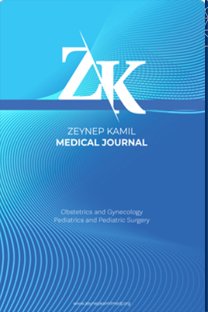Efficacy of transcutaneous posterior tibial nerve stimulation in women with an idiopathic overactive bladder
Efficacy of transcutaneous posterior tibial nerve stimulation in women with an idiopathic overactive bladder
___
- 1. Abrams P, Andersson KE, Birder L, Brubaker L, Cardozo L, Chapple C, et al. Fourth international consultation on incontinence recommendations of the international scientific committee: Evaluation and treatment of urinary incontinence, pelvic organ prolapse, and fecal incontinence. Neurourol Urodyn 2010;29(1):213–40.
- 2. Irwin D, Kopp Z, Agatep B, Milsom I, Abrams P. Worldwide prevalence estimates of lower urinary tract symptoms, overactive bladder, urinary incontinence and bladder outlet obstruction. BJU Int 2011;108(7):1132– 8.
- 3. Nandy S, Ranganathan S. Urge incontinence. 2020 Sep 23. In: StatPearls. Treasure Island, FL: StatPearls Publishing; 2021.
- 4. Lightner DJ, Gomelsky A, Souter L, Vasavada SP. Diagnosis and treatment of overactive bladder (non-neurogenic) in adults: AUA/SUFU guideline amendment 2019. J Urol 2019;202(3):558–63.
- 5. MacLachlan LS, Rovner ES. New treatments for incontinence. Adv Chronic Kidney Dis 2015;22(4):279–88.
- 6. Manriquez V, Guzman R, Naser M, Aguilera A, Narvaez S, Castro A, et al. Transcutaneous posterior tibial nerve stimulation versus extended release oxybutynin in overactive bladder patients. A prospective randomized trial. Eur J Obstet Gynecol Reprod Biol 2016;196:6–10.
- 7. Ammi M, Chautard D, Brassart E, Culty T, Azzouzi AR, Bigot P. Transcutaneous posterior tibial nerve stimulation: Evaluation of a therapeutic option in the management of anticholinergic refractory overactive bladder. Int Urogynecol J 2014;25(8):1065–9.
- 8. Irwin GM. Urinary incontinence. Prim Care 2019;46(2):233–42.
- 9. Nguyen MT, Armstrong AA, Wieslander CK, Tarnay CM. Now anyone can Kegel: One-time office teaching of pelvic floor muscle exercises. Female Pelvic Med Reconstr Surg 2019;25(2):149–53.
- 10. Booth J, Connelly L, Dickson S, Duncan F, Lawrence M. The effectiveness of transcutaneous tibial nerve stimulation (TTNS) for adults with overactive bladder syndrome: A systematic review. Neurourol Urodyn 2018;37(2):528–41.
- 11. Schreiner L, dos Santos TG, Knorst MR, da Silva Filho IG. Randomized trial of transcutaneous tibial nerve stimulation to treat urge urinary incontinence in older women. Int Urogynecol J 2010;21(9):1065–70.
- 12. Azuri J, Kafri R, Ziv-Baran T, Stav K. Outcomes of different protocols of pelvic floor physical therapy and anti-cholinergics in women with wet over-active bladder: A 4-year follow-up. Neurourol Urodyn 2017;36(3):755–8.
- 13. Valles-Antuña C, Pérez-Haro ML, de González-Ruiz LC, Quintás-Blanco A, Tamargo-Diaz EM, García-Rodríguez J, et al. Transcutaneous stimulation of the posterior tibial nerve for treating refractory urge incontinence of idiopathic and neurogenic origin. Actas Urol Esp 2017;41(7):465–70.
- 14. Ramírez-García I, Blanco-Ratto L, Kauffmann S, Carralero-Martínez A, Sánchez E. Efficacy of transcutaneous stimulation of the posterior tibial nerve compared to percutaneous stimulation in idiopathic overactive bladder syndrome: Randomized control trial. Neurourol Urodyn 2019;38(1):261–8.
- 15. Ramírez-García I, Kauffmann S, Blanco-Ratto L, Carralero-Martínez A, Sánchez E. Patient-reported outcomes in the setting of a randomized control trial on the efficacy of transcutaneous stimulation of the posterior tibial nerve compared to percutaneous stimulation in idiopathic overactive bladder syndrome. Neurourol Urodyn 2021;40(1):295–302.
- 16. Sönmez R, Yıldız N, Alkan H. Efficacy of percutaneous and transcutaneous tibial nerve stimulation in women with idiopathic overactive bladder: A prospective randomised controlled trial. Ann Phys Rehabil Med2021;2021:101486.
- 17. Slovak M, Chapple CR, Barker AT. Non-invasive transcutaneous electrical stimulation in the treatment of overactive bladder. Asian J Urol 2015;2(2):92–101.
- 18. Teixeira Alve A, Azevedo Garcia P, Henriques Jácomo R, Batista de Sousa J, Pereira LB, Barbaresco Gomide Mateus L, et al. Effectiveness of transcutaneous tibial nerve stimulation at two different thresholds for overactive bladder symptoms in older women: A randomized controlled clinical trial. Maturitas 2020;135:40–6.
- 19. Peters KM, Carrico DJ, Wooldridge LS, Miller CJ, Macdiarmid SA. Percutaneous tibial nerve stimulation for the long-term treatment of overactive bladder: 3-year results of the STEP study. J Urol 2013;189(6):2194– 201.
- 20. Rai BP, Cody JD, Alhasso A, Stewart L. Anticholinergic drugs versus non-drug active therapies for non-neurogenic overactive bladder syndrome in adults. Cochrane Database Syst Rev 2012;12(12):CD003193.
- ISSN: 1300-7971
- Yayın Aralığı: Yılda 4 Sayı
- Yayıncı: Ali Cangül
An overview of anaphylaxis in children
Ectopic pelvic kidney: Prenatal diagnosis and management
Gürcan TÜRKYILMAZ, Bilal ÇETİN
Funda GÜNGÖR UĞURLUCAN, Cenk YAŞA, Sina ARMAN, Ekin İlke ŞEN, Nalan ÇAPAN, Gülşah GULA, Ayşe KARAN
External anal sphincter repair by the overlapping method in obstetric anal sphincter injury syndrome
Filiz AKYÜZ, Sami AÇAR, Erman ÇİFTÇİ
Effects of topical Povidone-iodine on thyroid function in surgical newborns
Ayşenur CELAYİR, Sırma Mine TİLEV, Burcu ARI, Tuba ERDEM
Anxiety, quality of life, eating behaviors, and sexual life in women with polycystic ovary syndrome
Gülfem BAŞOL, Sevil KİREMİTLİ, Tunay KİREMİTLİ, Paşa ULUĞ, Kemine UZEL
Evaluation of blood pressures measured at the clinic and during exercise test in children
Nurdan EROL, Çiğdem EROL, İlke AKTAŞ
Seroprevalence of Varicella-Zoster in the first trimester of pregnancy
